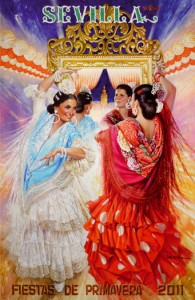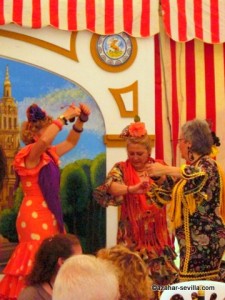Today’s post is by guest contributor Kim from Becoming Sevillana
 During my year and a half in Seville, I have been trying to find out what it means to be Sevillana. Some aspects of my British roots are ingrained in me, such as the incessant need to apologise and give thanks unnecessarily, but like most Sevillanos I long for the festive season, for Semana Santa (Holy Week), and most importantly, la feria de abril.
During my year and a half in Seville, I have been trying to find out what it means to be Sevillana. Some aspects of my British roots are ingrained in me, such as the incessant need to apologise and give thanks unnecessarily, but like most Sevillanos I long for the festive season, for Semana Santa (Holy Week), and most importantly, la feria de abril.
As its name indicates, it is normally held in April, two weeks after Easter, which is later this year, making it fall in May (2nd-8th). It is a week-long celebration revolving around friends, family, eating and drinking. It is a sensory overload – of colour: women sporting their vibrant trajes de flamenca and funnily-named pinstriped casetas lining the streets – and music: the constant melody of sevillanas will definitely be an earworm by the end of the week.
Feria takes place in the Los Remedios area, to the west of the city. The real (feria site) is an impressive 450,000m², a vast space that sits empty for the remaining 51 weeks of the year. The land is divided into 15 streets named after bullfighting greats, and accommodates 1048 casetas – temporary marquee style establishments, where people meet, eat, get merry and of course dance sevillanas.
Feria is very much for Seville’s people, but that does not mean that outsiders are not welcome. Unlike other ferias in Andalusia, it can be almost impossible to get inside a caseta as they are owned by wealthy families, companies or organisations, and unless you are acquainted with a member it is unlikely that you will get past the bouncer on the door. Casetas are extremely sought after as was demonstrated this year when 15 were given up by their “owners” after having been hit by the crisis. The groups on the top of the list had been waiting over two decades to be given the privilege. However, this should not discourage anyone from further afield from going to feria as there are many public casetas belonging to political parties or barrios (neighbourhoods) which allow anyone in. Visitors should also remember that thrifty Sevillanos do not tend to eat at the feria – food and drink can be quite expensive, raciones (full portions) are usually served instead of tapas and rebujito (a mix of manzanilla and 7-up) is served in pitchers.
 Although feria starts on Monday, this evening is usually reserved for the caseta-owners and their invited guests and it is locally known as el pescaito as a platter of various fried fish is served up. Then at around midnight is the alumbrao, which is when all 214,750 of the light bulbs hung across the streets and adorning the portada are turned on. The portada is the enormous entrance gate (40m high and 50m wide), which is themed upon a certain characteristic or icon of Seville and changes every year. This year it commemorates the 500th anniversary of the first circumnavigation of the world, made by Magellan, whose fleet set sail from Seville in 1519. It aims to promote project 2019-2022 which hopes to put Seville on the map once more.
Although feria starts on Monday, this evening is usually reserved for the caseta-owners and their invited guests and it is locally known as el pescaito as a platter of various fried fish is served up. Then at around midnight is the alumbrao, which is when all 214,750 of the light bulbs hung across the streets and adorning the portada are turned on. The portada is the enormous entrance gate (40m high and 50m wide), which is themed upon a certain characteristic or icon of Seville and changes every year. This year it commemorates the 500th anniversary of the first circumnavigation of the world, made by Magellan, whose fleet set sail from Seville in 1519. It aims to promote project 2019-2022 which hopes to put Seville on the map once more.
Feria is very much two events – feria by day and feria by night.
Feria by day is a family-friendly event, closer to its roots of the cattle fair. Although showing bulls and oxen is no longer a feature, it is definitely more folkloric – women dress in traditional, figure-hugging trajes de flamenca and the real becomes a scene of years bygone, as many people prefer to travel by horse (wearing traje de corto) or in a horse and cart. Much food is eaten, there is a wide variety to choose from (jamón, prawns, Spanish omlette), and an incredible amount of wine is consumed, mainly manzanilla (in the form of rebujito) and vino fino, two varieties of Jerez Sherry.
 Sevillanas are synonymous with feria and many people are extremely good at dancing them. I have earnestly been trying to learn, and imagine that it will still take many rebujitos for me to pluck up the courage to get on the dance floor (again showing my British streak). It is danced in pairs and consists of four parts, each one including many steps and turns: arm and leg coordination is essential!
Sevillanas are synonymous with feria and many people are extremely good at dancing them. I have earnestly been trying to learn, and imagine that it will still take many rebujitos for me to pluck up the courage to get on the dance floor (again showing my British streak). It is danced in pairs and consists of four parts, each one including many steps and turns: arm and leg coordination is essential!
For the young and young-hearted is the aptly named Calle del Infierno (Hell Street), home of the cacharritos (fairground rides). The typical big wheel, bumper carts and fun house is featured, but my favourite has to be the tren de la bruja a nonsensical ride where you board a train which continuously loops, and being armed with nothing more than a long balloon, you have to defend yourself from being walloped by the witch’s broom.
As the daylight fades and the farolillos (lanterns) light up, families start to make their way home and the revellers arrive to join the hardcore feriantes for a much more intense party until the sun comes up. Night time feria’s still got sevillanas, food and of course lots of drink, but there aren’t as many flounced dresses – although people still tend to dress smartly, wearing outfits bought especially for the festive period.
Although I still won’t have converted into a true feriante, due to my working commitments, I can honestly claim to be just as excited as any home-grown one. I can’t wait to step into my very own traje, to fix my big red flower in my hair and swish my way through the portada, hoping it will bring me good luck for the coming year.

Feria de Abril
3 – 8th May 2011